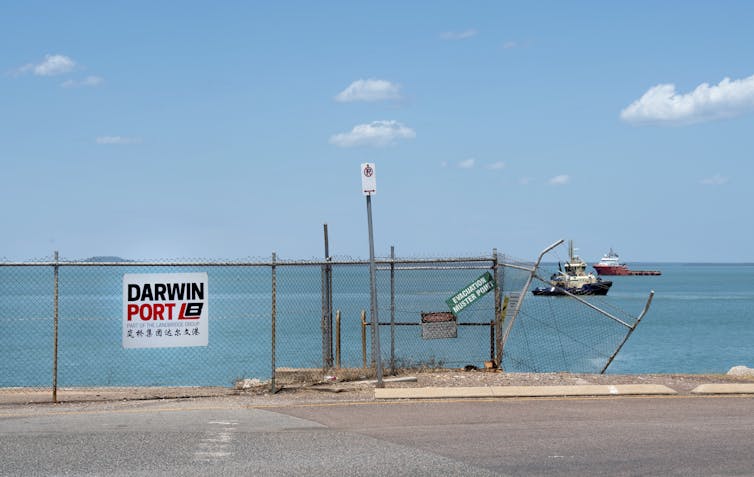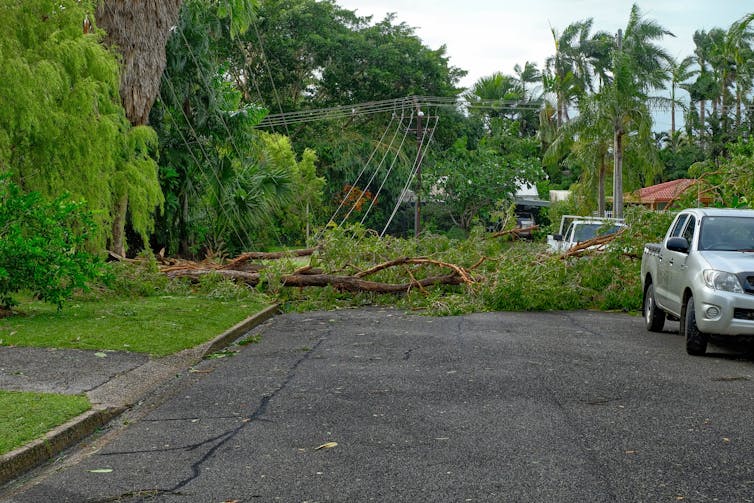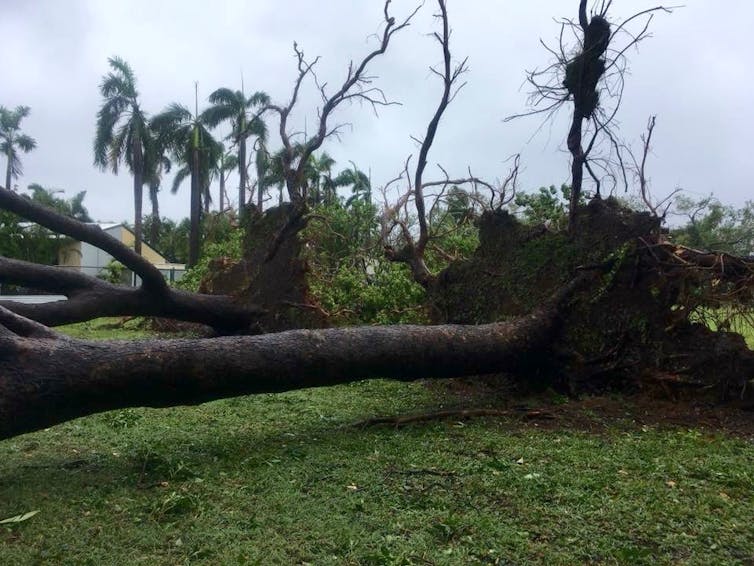Major Earthquake North of Darwin Sends Jitters Through Northern Australia

John Garrick, Charles Darwin University
An agreement between Darwin’s city council and an overseas municipal counterpart normally wouldn’t attract much attention. Local government officials love signing such deals. Darwin already has no less than six “sister city” arrangements, including with the Chinese city of Haikou.
But attention has been drawn to Darwin’s newly minted “friendship” deal with Yuexiu District, in Guangzhou, due to Chinese media describing it as part of President Xi Jinping’s signature Belt and Road Initiative.
This suggests Chinese authorities regard Darwin as having strategic significance.
It invites reflection on the wisdom, three years ago, of the Northern Territory government deciding to lease the Port of Darwin (now known as Darwin Port) to a Chinese company for 99 years – and of the federal government going along with it.
At the time the new owner, billionaire Ye Cheng, claimed the Darwin port deal was “our involvement in One Belt, One Road”. This was discounted by some commentators as hyperbole, an attempt to curry favour with the Chinese government.
But now, by design or not, the Darwin port deal increasingly looks like a blueprint for how Chinese interests can take control of foreign ports – as it is doing by various means around the world – without arousing local opposition. Quite the reverse. All levels of Australian government have encouraged it.
It makes Darwin an interesting case study – a point of contest between the strategies of the US and China. Darwin’s port is under Chinese control, while thousands of US marines are based in the city, as part of the US “Pacific pivot” seen by many as an effort to contain China’s influence in the region.

The deal to lease parts of the port followed successive federal governments refusing to fund necessary upgrading of the port’s infrastructure to meet growing demand.
Infrastucture Australia advised privatisation. Rather than sell outright, the territory government decided to lease the port, and sell a controlling stake in the port’s operator.
Landbridge Australia, a subsidiary of Shandong Landbridge, won the 99-year lease with its bid of A$506 million in November 2015.
Shandong Landbridge has substantial and varied interests including port logistics and petrochemicals. Though privately owned, like many Chinese companies it has strong ties to the ruling Chinese Communist Party.
The company knows how to cultivate political connections. In Australia it gave influential Liberal Party figure and former trade minister Andrew Robb an $880,000 job just months after he retired from parliament.
Read more:
Chinese influence compromises the integrity of our politics
The bid for the port was examined and approved by the Foreign Investments Review Board, the Defence Department and ASIO.
But the deal put Darwin directly in the crossfire between US and Chinese interests. Then US president Barack Obama expressed concern about the lack of consultation. Former deputy secretary of state Richard Armitage said he was “stunned” that Australia had “blind-sided” its ally.
While the centre of US-Chinese tensions is the South China Sea – where China has militarised reefs in disputed waters – Darwin is important because it is the southern flank of US operations in the Pacific.
Zhang Jie, a researcher at the Chinese Academy of Social Sciences, wrote in 2015 about the concept of “first civilian, later military” – in which commercial ports are to be built with the goal of slowly being developed into “strategic support points” – to assist China defending maritime channel security and control key waterways.
Military-civilian integration was among the goals China set in its 13th five-year plan for 2016-20. President Xi subsequently established an integration committee to oversee civilian and military investment in technology.
As with other Chinese port acquisitions, such as in Sri Lanka, Pakistan, Greece and Djibouti, Landbridge is interested in acquiring and developing not only Darwin’s port facilities but nearby waterfront property.
But the Darwin port deal differs in significant ways to other port acquisitions.
It is a far cry from the “debt-trap colonialism” China stands accused of using to gain leverage over other foreign governments, such as Sri Lanka and Nepal.
Read more:
Soft power goes hard: China’s economic interest in the Pacific comes with strings attached
Landbridge has bought the lease, rather than a Chinese bank lending funds to the Northern Territory government to develop the port. If Landbridge was to default, it would lose its money. Any attempt by Landbridge to use the port as security to borrow money from a Chinese bank would trigger renegotiation of the lease.
The territory government retains a 20% stake in the port operator and has a say in key appointments such as the chief executive and chief financial officer. But it will not share any profit that Landbridge may eventually make.
That potential is a long way off. Landbridge Australia reported a loss of A$31 million for the 2017 financial year, with its total borrowings rising to A$463 million. If the deal falls over, the government will need to seek new equity partners. But its immediate commercial risks are relatively contained.
Yet risk exposure may take other forms. China’s strategy is very long-term. Darwin is now on the front line in managing tensions between Australia’s most important strategic ally and partner and its major trading partner. Balancing between powerful friends with competing interests may not prove easy.
Read more:
The risks of a new Cold War between the US and China are real: here’s why
There are indications of some recognition of this at the federal level. Australia’s foreign investment review processes have been tightened. A Critical Infrastructure Centre has been created to give extra national security advice. There has been some tweaking of rules about political parties accepting foreign donations.
But others may have learnt valuable lessons too.
Weaknesses in Australian governments at all levels have been revealed. They have been reactive, readily accepting the lure of pearls cast on our shores without considering longer-term currents. Foreign and strategic policy has effectively been left to the local level. While the federal government now seeks to shore up its interests in the Pacific with cash for infrastructure, similar commitments to investing in local infrastructure are essential.
Clumsiness and indecision do not serve Australian interests well.![]()
John Garrick, Senior Lecturer, Business Law, Charles Darwin University
This article is republished from The Conversation under a Creative Commons license. Read the original article.

Akhilesh Surjan, Charles Darwin University; Deepika Mathur, Charles Darwin University; Jonatan A Lassa, Charles Darwin University, and Supriya Mathew, Charles Darwin University
Darwin was directly in the path of Cyclone Marcus and suffered severe impacts from wind gusts up to 130km/hour on Saturday, March 17. Northern Territory authorities made no declaration of emergency, but the Insurance Council of Australia declared it a “catastrophe” for the Greater Darwin region. Marcus is considered the city’s second-worst cyclone since Tracy, which devastated Darwin on Christmas Eve 1974.
The good news is that no deaths have been reported. But had it been a category 4 or 5 cyclone, instead of category 2, how would the city have fared?
The post-Marcus chaos in Greater Darwin is not just “a real wake-up call”, but a typical case of lessons yet to be learned. For example, large shallow-rooted trees planted after Cyclone Tracy and overhead power lines brought down in the cyclone were both hazards that could have been avoided. Darwin is now engaged in a long, difficult and costly clean-up.
Indigenous knowledge as well as the Bureau of Meteorology’s historical records confirm that tropical cyclones are not new to Northern Australia. According to the BOM:
There are on average 7.7 days per season when a cyclone exists in the Northern Region.
//platform.twitter.com/widgets.js
So was there complacency among some residents, as emergency services warned? Did infrastructure providers underestimate the threat? In hot and humid weather, over one-third of Darwin’s population went without power for several days and safe-to-drink tap water for 48 hours. Communication networks were patchy for days.
What was the reluctance in seeking immediate support from other states despite banks and insurers considering this a catastrophe? Was it due to Commonwealth disregard for the Top End in general?
There have been at least two opposing views on the impact of the cyclone. The first is a more optimistic one, largely because no one got killed or seriously injured. Community members spontaneously helped one another in the immediate aftermath.
On this view, although preparedness might have varied, people in general were prepared. Power outages for a few days were a “first world problem”. Most households were ready, for example, to use camping gas cookers.
Volunteers visited and helped vulnerable groups such as aged and sick people. Emergency responders, defence staff and infrastructure restoration teams are working tirelessly to return the city to normalcy.
On the other hand, Marcus uprooted thousands of trees across Greater Darwin, mostly African mahoganies, which were planted for revegetation after Tracy.

Around 25,800 of about 60,000 properties across Greater Darwin were cut off from power. Even after a week many are still living in darkness. Power outages had cascading effects: traffic signals weren’t working for days at many places and food was left to rot in the heat.
Water was cut off in places. For about 48 hours people were urged to boil tap water before drinking, cooking or brushing teeth. The Health Department issued a warning about melioidosis, a life-threatening disease spread by contact with soil, mud and surface water.
Fallen trees blocked many roads and caused mild to severe damage to residential, commercial and public premises. Outdoor areas were cordoned off for safety.
Educational institutions were closed for at least a day. People who didn’t own a car or were unable to drive were disadvantaged for almost three days until public transport was running again.
At several locations, tree branches are still hanging dangerously over roads, pavements, parks and roofs. Anywhere in the city or suburbs, you see major and minor roads, parks and beachfronts dotted with uprooted trees and fallen branches. The roadside piles of logs and green waste are likely to remain there for some time, as their removal is not an “emergency priority”.
Waste facilities are struggling to cope. The morning after the cyclone, vehicles queued for hours at the green waste facility. It is yet to be ascertained if arrangements can be made to manage the huge quantities of green waste.
United Nations Environment Program (UNEP) guidelines note that waste debris presents opportunities as “either a source of income or as a reconstruction material, and [can] reduce burdens on natural resources that might otherwise be harvested for reconstruction”.
An evaluation of green waste would help understand its recovery value. Research suggests that disaster waste management can account for 5–10% of the total recovery costs, often exceeding that of health care and education.
In October 2004, a typhoon devastated Toyooka in Japan, producing 45,000 tonnes of waste – 1.5 years of the city’s usual waste production. The 2011 tsunami in Japan produced the equivalent of of 9 years’ worth of municipal solid waste in Iwate prefecture and 14 years’ worth in Miyagi prefecture.
Local government is considering removing mahogany trees, which were introduced after Tracy, because of their fast growth and the expansive shade their dense canopies provide.
Globally, environmental dimensions of disasters are less recognised compared with social and economic dimensions. However, the loss of dense trees and the valuable ecosystem services these offer calls for environmental recovery to be a priority as well.
A 2013 study reveals that large sums of taxpayers’ money is typically spent following disasters, whereas increasing pre-disaster investments can achieve cost savings and resilience.
As an example, the territory government is offering relief payments between A$250 and A$650 for households that were without power for 72 hours or more. The importance of putting power lines underground was recognised more than a decade ago but the work is incomplete due to lack of political will.
This is the time to ask questions such as: what will be the scale of devastation and cost and duration of recovery if a category 4 or 5 cyclone hits Darwin? The next cyclone after Marcus, Nora, was expected to be a category 4 storm but was downgraded to category 3 when it hit the western coast of Cape York on March 25.
Why not prioritise transformation of critical infrastructure, such as shifting all power lines underground? What role can cost-benefit analysis play to achieve resilience to category 4 or 5 cyclones and other natural disasters?
![]() More broadly, how can we learn from the past? What are the new lessons we can take forward from Cyclone Marcus? And how do we inspire a city to work towards creating “Resilient Darwin’”?
More broadly, how can we learn from the past? What are the new lessons we can take forward from Cyclone Marcus? And how do we inspire a city to work towards creating “Resilient Darwin’”?
Akhilesh Surjan, Associate Professor, Humanitarian, Emergency and Disaster Management Studies, Charles Darwin University; Deepika Mathur, Researcher in sustainable architecture, Charles Darwin University; Jonatan A Lassa, Senior Lecturer, Humanitarian Emergency and Disaster Management, Charles Darwin University, and Supriya Mathew, Postdoctoral researcher, Charles Darwin University
This article was originally published on The Conversation. Read the original article.
With bushfires still raging in Victoria, New South Wales has now become a state burdened with a natural disaster. Queensland has been flood-stricken for weeks and now Darwin in the Northern Territory is also expecting flooding.
Some 62% of Queensland is now affected by flooding following weeks of torrential rain, caused by an active monsoonal trough and a cyclone. Some areas are expected to be flooded for weeks.
In New South Wales the north-western town of Bourke has received 2/3 of its annual rainfall in the space of 15 hours on the weekend and has now been declared a natural disaster area, with major flooding in and around the town.
Coastal New South Wales has been inundated since the weekend, with some towns having received their highest amount of rainfall in a five day period for over 35 years. Coffs Harbour has received well over 600 mm in the same period.
Bellingen and Thora are now surrounded by flood waters and a number of rivers up and down the New South Wales coast between Tweed Heads and the Hunter are now in flood or on flood watch, including the Tweed River, the Richmond River, the Wilsons River, the Bellinger River, the Macleay River, the Hastings River, the Manning River, the Orara River, the Nambucca River, the Williams River, the Paterson River, the Hunter River and the Myall River.
Towns affected by flooding include such centres as Bellingen, Wauchope, Port Macquarie and Bulahdelah.
To add to the growing flood threat, another trough and east coast low is developing off the New South Wales Coast and this is also expected to follow the previous system, bringing with it more heavy rain. Heavy rain from this new system is already falling on the north coast.
As these systems move further south toward bushfire ravaged Victoria, they are weakening and the potential for rain is lessening. So far Victoria has received very little rain and bushfires continue to burn.
Further off the Queensland coast there is a tropical depression that is making its way towards the Queensland coast. This could yet develop into a tropical cyclone and bring even more severe weather to Queensland.
In the Northern Territory several towns have been evacuated due to the heavy rain and flooding. Darwin also has a current flood threat warning in place.
Flood waters are now beginning to spill over the South Australian border, making their way towards Lake Eyre.